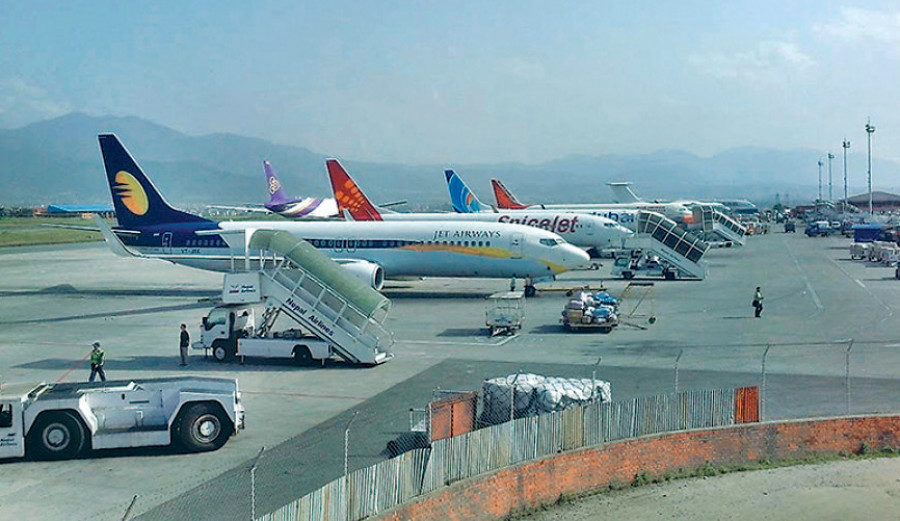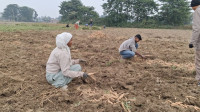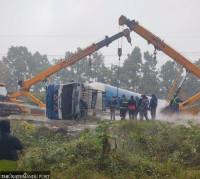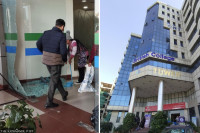National
Cabinet takes a slew of decisions to curb virus spread but stops short of making them public
Decisions include no flights and long-distance transport until August 31, tightening of entry into the Valley, and reducing the number of entry points from India to 10 from the present 20.
Tika R Pradhan & Sangam Prasain
Alarmed by the growing number of Covid-19 cases across the country, especially in Kathmandu Valley which has a large mobile population, the Oli administration’s meeting on Monday evening was keenly awaited. The meeting lasted hours, but the outcome was sketchy.
Most of the ministers chose to switch their mobile phones off, while there was no briefing by the government spokesperson, Yubaraj Khatiwada, also the finance minister.
At least two ministers the Post spoke with said that the Cabinet had taken decisions in line with the recommendations made by the meeting of Coronavirus Crisis Management Committee held on Sunday in the presence of mayors of Kathmandu Valley.
“Things would be like during the days of lockdown,” a minister told the Post requesting not to be named, as decisions were not made public immediately.
During his last briefing about the Cabinet meeting on August 6, Khatiwada had said that there won’t be a lockdown, as the term invoked psychological terror among the general public.
“All documents regarding Monday’s decisions are with the chief secretary,” said another minister who also requested anonymity.
The two ministers the Post talked to said that international and domestic flights and long-distance public transport will remain closed until August 31. The restrictions, however, may go beyond September 15 or even further, depending on Covid-19 cases in the country, according to one of the ministers.
Earlier on July 20, the government had decided to allow international and domestic airlines to operate from August 17. International commercial flights to Nepal have been banned since the third week of March in the wake of the global spread of the coronavirus.
On March 20, the government had banned all passengers, including Nepalis, from entering the country from the European Union territories, including the United Kingdom, West Asia, Gulf countries and countries like Iran, Turkey, Malaysia, South Korea and Japan. Four days later, on March 24, the government imposed a complete lockdown.
As far as Kathmandu Valley is concerned, local governments have decided to impose some strict restrictions for at least two weeks.
All municipalities in Kathmandu Valley, except Bhaktapur, have decided to close all non-essential services for the 15 days starting Tuesday.
Valley Municipalities’ Forum, a grouping of mayors of Kathmandu Valley, earlier on Monday had met to draft suggestions for the government on ways to control the spread of the virus.
As per the forum’s suggestions, the Cabinet has decided to tighten the entry of people into the Valley through all entry points, according to one of the ministers who spoke to the Post. The majority of the recent coronavirus cases in the Valley have been seen among those people who arrived here recently, according to health officials.
Since the lifting of the lockdown on July 21, the country has seen a sudden spike in Covid-19 cases, with the national tally reaching 23,310 so far.
As of Monday, 1,178 people have been infected with the virus in Kathmandu Valley. On Monday, 338 new cases were reported across the country. Of them, 44 were from the Valley. The Covid-19 death toll stands at 79, with Kathmandu Valley reporting eight deaths so far, according to the Health Ministry.
Since the lockdown was lifted, Kathmandu Valley has seen 826 coronavirus cases. In Kathmandu Metropolitan City, coronavirus infection has been reported in all 32 wards.
The sudden rise in the number of cases has put the Oli government, which has faced criticism for failing to step up efforts to fight the pandemic, on the back foot.
When the Oli administration imposed the lockdown, the country had reported just two Covid-19 cases. When the lockdown was lifted, the number of cases had crossed the 17,000 mark.
Businesses had taken a beating while people from the local economic strata suffered the most. The government itself was struggling with its coffers getting empty, as it was unable to collect revenue.
Public health experts have for long criticised the government for failing to use the lockdown period as an opportunity to step up measures like setting up quarantine and isolation facilities, increasing hospital beds, providing training to health workers and expanding capacity for testing.
In the lead up to Monday’s Cabinet meeting, there were talks that decisions on various measures could be taken avoiding the term lockdown, for it could once again invite criticism for the government.
According to one minister, the meeting decided to reduce the designated 20 entry points to the country from India to 10 and strictly prohibit people, including shoppers, from crossing the border points.
The government offices will be allowed to mobilise only 50 percent of employees or less under strict implementation of health protocols, said the minister.
Similarly, the government has decided to restrict gatherings inside Kathmandu Valley and ban festival celebrations.
Monday’s Cabinet also decided to allow factories to operate in Kathmandu Valley only if they set up their private quarantines ensuring strict health protocols.
The recommendation was made by Valley Municipalities’ Forum saying that mass movement of factories and industrial workers may contribute to rapid spread of the virus.
“We are not aware of the decision but if it has been made, it indirectly means factory owners have to keep their workers indoors. This may be possible only in big factories because they have enough spaces,” said Pashupati Murarka, former president of the Federation of Nepalese Chambers of Commerce and Industry, and owner of Murarka Organisation. “It may be an important decision considering the increase in Covid-19 cases. But it’s not practical at all.”




 6.12°C Kathmandu
6.12°C Kathmandu














%20(1).jpg&w=300&height=200)

